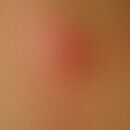Synonym(s)
HistoryThis section has been translated automatically.
Portal, 1685; Vohwinkel, 1929; Wigley, 1929; Camisa and Rossana 1984
DefinitionThis section has been translated automatically.
You might also be interested in
EtiopathogenesisThis section has been translated automatically.
Evidence to date has shown 8 autosomal dominant frameshift mutations in the loricrin gene. The LORICRIN gene (LOR) is mapped to chromosome 1q21. Loricrin is an important component of the"cornified envelope". Mutations of the loricrin gene have also been detected in cases of erythrokeratoderma progressiva symmetrica.
ClinicThis section has been translated automatically.
Massive, diffuse palmoplantar keratoses with livid margin, hyperhidrosis, contractures as well as typical anular keratotic lacerations up to the loss of acra. Keratoses can also occur on ankles (knuckle pads), knees, forearms and elbows. Some children are born as collodion babies.
TherapyThis section has been translated automatically.
Hyperkeratoses such as lacerations generally respond well to systemic retinoids such as acitretin (neotigason) or isotretinoin (Menta Simonsen Nico et al. 2017).
Dosage for acitretin: Initially 0.5 mg/kg bw/day for 4-6 months, slowly decrease according to the clinic. Cave! Monitor bone growth in children, caution in women of childbearing potential! Externally symptomatic according to the keratosis palmoplantaris diffusa circumscripta. Otherwise according to the clinical appearance.
Progression/forecastThis section has been translated automatically.
Recently, a special form of regression phenomenon has been described in this clinical picture. Clinically, progressive, whitish regression zones in lesioned skin were observed in which the original LOR mutation was no longer detectable. This phenomenon is described as revertant mosaicism. These are revertant mutants in which an earlier mutation is reversed by another mutation. This phenomenon represents a kind of natural gene therapy (Suzuki S et al. 2019).
An analogous regression phenomenon is also found in congenital reticular ichthyosiform erythroderma , where the original keratin mutation is lost through spontaneous recombination events, resulting in a "confetti-like" clinical appearance.
Note(s)This section has been translated automatically.
The clinical symptoms overlap with those of Bart-Pumphrey syndrome, which also has a mutation of the GJB2 gene. However, the lacing rings are missing in this syndrome.
Vohwinkel keratoderma must also be distinguished. Some authors assign keratoderma with strangles only to the "Keratoma hereditarium mutilans" of Vohwinkel keratoderma and not to Loricrin kratoderma (Oji v. 2018).
LiteratureThis section has been translated automatically.
- Atabay K et al (2001) Keratoderma hereditarium mutilans (Vohwinkel syndrome): an unsolved surgical mystery. Plast Reconstr Surgery 108: 1276-1280
- Bergonse FN et al (2003) Olmsted syndrome: the clinical spectrum of mutilating palmoplantar keratoderma. Pediatric dermatol 20: 323-326
- Ishida-Yamamoto A et al (2000) Mutant loricrin is not crosslinked into the cornified cell envelope but is translocated into the nucleus in loricrin keratoderma. J Invest Dermatol 115: 1088-1094
- Matsumoto K et al (2001) Loricrin keratoderma: a cause of congenital ichthyosiform erythroderma and collodion baby. Br J Dermatol 145: 657-660
- Menta Simonson Nico M et al (2017) Low-dose isotretinoin prevents amputation in loricrine palmopllantar keratosis. J Dtsch Dermatol Ges. 15: 664-666
- Nico MMS et al (2017) Low-dose isotretinoin prevents digital amputation in loricrin keratoderma
(Vohwinkel syndrome with ichthyosis). J Dtsch Dermatol Ges 15:665-667. - Oji (2018) Ichthyoses. In: Braun-Falco`s Dermatology, Venerology Allergology G. Plewig et al. (Hrsg) Springer Verlag S 1080
- O'Driscoll J et al (2002) A recurrent mutation in the loricrin gene underlies the ichthyotic variant of Vohwinkel syndrome. Clin Exp Dermatol 27: 243-246
- Peris K et al (1995) Keratoma hereditarium mutilans (Vohwinkels syndrome) associated with congenital deaf-mutism. Br J Dermatol 312: 617-620
- Suzuki S et al (2019) Somatic recombination underlies frequent revertant mosaicism in loricrinkeratoderma
. Life Sci Alliance 4;2(1). pii: e201800284. - Vohwinkel KH (1929) Keratoma hereditarium mutilans. Arch Dermatol Syph 158: 354-364
Incoming links (12)
Ainhum syndrome; Bart-pumphrey syndrome; Congenital reticular ichthyosiform erythroderma; Keratoma hereditarium mutilans; LOR Gene; Loricrin; Loricrin gene ; Olmsted syndrome; Peromellia; Pseudoainhum-like dermatosis; ... Show allOutgoing links (12)
Acitretin; Bart-pumphrey syndrome; Congenital reticular ichthyosiform erythroderma; Cornified envelope; Erythrokeratodermia progressive symmetrica; Hyperhidrosis (overview); Hyperkeratoses; Keratosis palmoplantaris diffusa with mutations in KRT 9; LOR Gene; Loricrin; ... Show allDisclaimer
Please ask your physician for a reliable diagnosis. This website is only meant as a reference.




